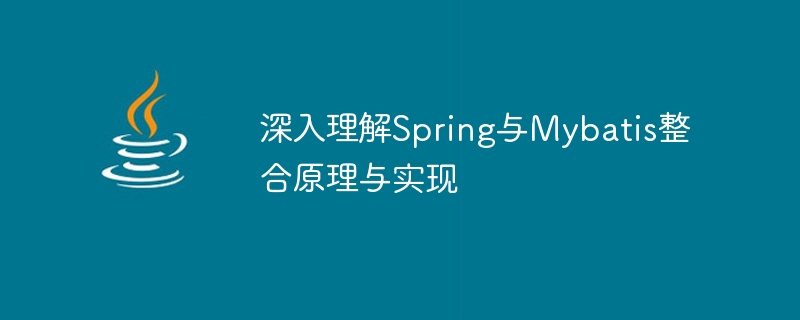Home >Java >javaTutorial >In-depth understanding of the principles and implementation of Spring and Mybatis integration
In-depth understanding of the principles and implementation of Spring and Mybatis integration
- 王林Original
- 2024-02-20 09:14:351185browse

In-depth understanding of the principles and implementation of the integration of Spring and Mybatis
1. Introduction
Spring and Mybatis are two open source frameworks widely used in Java development. Spring is a comprehensive application development framework that provides many features such as dependency injection, AOP, etc. Mybatis is a persistence framework through which the database can be easily operated. Integrating the two can better leverage their advantages and improve development efficiency and code quality.
2. Integration Principle
- Spring’s IOC container
Spring’s IOC (Inverse of Control) container implements dependency injection and can uniformly manage various beans. Important objects such as Mybatis's SqlSessionFactory can be injected into Spring's IOC container through configuration files or annotations. - Mybatis's SqlSessionTemplate
Mybatis's SqlSessionTemplate is a class that implements the SqlSession interface that can be used directly in Spring. Through it, you can easily inject SqlSession in Spring, eliminating the trouble of manually creating and closing SqlSession. - Spring's transaction management
Mybatis itself does not support transaction management, but after integrating with Spring, you can use Spring's transaction management function to manage database operations. By configuring the transaction manager, the methods of the Service layer or DAO layer are designated as transactions.
3. Integration implementation steps
The following are the steps to implement the integration of Spring and Mybatis, and corresponding code examples are given:
- Configuring data sources
In Spring's configuration file, configure the data source, for example, use Apache Commons DBCP2 connection pool:
<bean id="dataSource" class="org.apache.commons.dbcp2.BasicDataSource">
<property name="driverClassName" value="com.mysql.jdbc.Driver" />
<property name="url" value="jdbc:mysql://localhost:3306/test" />
<property name="username" value="root" />
<property name="password" value="password" />
</bean>- Configure SqlSessionFactory
In Spring's configuration file, configure SqlSessionFactory and inject Data source:
<bean id="sqlSessionFactory" class="org.mybatis.spring.SqlSessionFactoryBean">
<property name="dataSource" ref="dataSource" />
<property name="mapperLocations" value="classpath:mapper/*.xml" />
</bean>- Configure SqlSessionTemplate
Inject SqlSessionFactory into SqlSessionTemplate:
<bean id="sqlSessionTemplate" class="org.mybatis.spring.SqlSessionTemplate">
<constructor-arg name="sqlSessionFactory" ref="sqlSessionFactory" />
</bean>- Configure transaction manager
Configure Spring Transaction manager and inject the data source into:
<bean id="transactionManager" class="org.springframework.jdbc.datasource.DataSourceTransactionManager">
<property name="dataSource" ref="dataSource" />
</bean>- Configure transaction notification
Configure transaction notification through AOP, for example, add @Transactional annotation on the method of the Service layer:
@Service
@Transactional
public class UserServiceImpl implements UserService {
// ...
}Through the above steps, the integration of Spring and Mybatis is achieved.
4. Summary
This article introduces the integration principles and implementation steps of Spring and Mybatis, and demonstrates the specific integration process through configuration files and code examples. In actual development, rationally utilizing the advantages of Spring and Mybatis can improve development efficiency and code quality, and better meet project needs. It is hoped that readers can flexibly use these two frameworks for development after understanding the integration principles and implementation steps.
The above is the detailed content of In-depth understanding of the principles and implementation of Spring and Mybatis integration. For more information, please follow other related articles on the PHP Chinese website!

